What Are Smart Meters? Electricity meters have come a long way since their invention in the 1880s....
Understanding Isolation in DC-DC Converters
DC-to-DC converters play a critical role in power electronics by enabling manipulation of a DC power source' voltage level. These converters come in a variety of types used across both industrial and consumer electronics. Notably, DC-DC converters can be classified into two distinct categories: isolated and non-isolated. The primary differentiating factors between these groups are cost and isolation characteristics.
Isolated DC-DC converters utilize a transformer to achieve galvanic isolation between the input and output circuits. This magnetic coupling separates the input and output grounds, preventing current flow while enabling power transfer. Flyback and forward converters are isolated counterparts to the non-isolated buck-boost and buck converters, respectively. These isolated converters, particularly flyback and forward topologies, are employed when galvanic isolation is a critical design requirement.
In isolated DC-DC converters, the input and output sides are electrically isolated, each with its own ground reference. Signal transmission between these sides can be achieved electromagnetically or optically using various isolation techniques: transformers, capacitors, or optocouplers.
Among these, transformer-based isolation is the most common due to its robustness and wide applicability. Transformers employ magnetic coupling to transfer energy between the input and output circuits. This magnetic isolation eliminates a direct current path, improving safety for applications with different voltage levels. Additionally, it mitigates high-frequency noise transfer between the circuits.
While traditionally used with AC signals, transformers offer valuable benefits in DC-DC converters. They provide galvanic isolation between input and output grounds, albeit at the cost of increased system complexity.
Flyback Converters
Flyback converters offer an isolated alternative to buck-boost converters for engineers. They achieve galvanic isolation through a transformer, enabling safe operation with disparate input and output grounds. This advantage comes at the cost of increased complexity compared to the non-isolated counterpart. The transformer introduces higher di/dt noise, potentially impacting efficiency and causing bulkier designs. During operation, energy is stored in the transformer's primary winding (N1) when the switch (S) is turned on. This energy is then transferred to the secondary winding (N2) when the switch turns off, enabling the desired voltage conversion. (Figures 1 and 2 can be referenced for a visual comparison of isolated vs non-isolated DC-DC converter topologies).
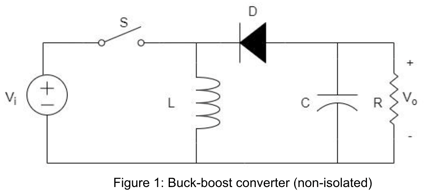
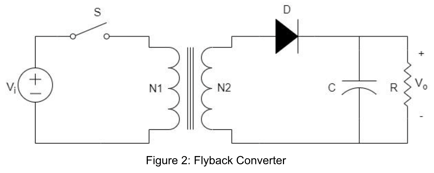
Forward Converters
Forward converters build upon buck converters by incorporating a transformer for galvanic isolation between input and output. This maintains the buck converter's advantages while enabling a safe voltage separation. To address transformer saturation, forward converters can utilize a more complex three-winding design, improving efficiency with a more complex design. A key advantage of forward
converters is their continuous energy transfer during switch S's "ON" state. This continuous transfer translates to higher efficiency and power density compared to non-isolated buck converters. (Figures 3 and Figure 4 show the comparison between isolated and non-isolated topologies).
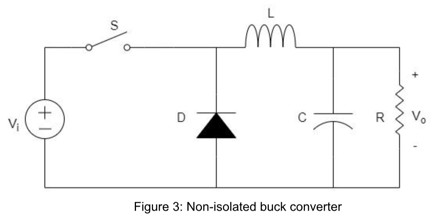
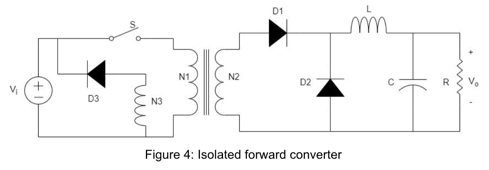
Safety
Due to galvanic isolation, which separates input and output and eliminates current flow between them, these converter types are ideal for high-to-low voltage conversions. This isolation barrier is critical for protecting the low-voltage DC output, typically sourced from the utility grid, by preventing electrical shock hazards and mitigating the risk of faults and other electrical dangers.
When it comes to electrical safety in converters, understanding isolation grades is helpful. These grades, defined by safety standards and regulations, specify the minimum allowable voltage withstand between input and output circuits. This isolation prevents electrical shock and equipment damage.
- Functional Isolation: This baseline grade offers the least protection. It utilizes a single isolation barrier but provides no defense against electrical shock. While it breaks ground loops, it's only suitable for applications where safety is not a critical concern.
- Basic Isolation: This grade prioritizes electrical safety. It provides a single isolation barrier that effectively guards against electric shock under normal operating conditions.
- Double Isolation: This enhanced safety measure combines basic isolation with an additional, independent isolation layer. This redundancy ensures protection even if the primary isolation barrier fails.
- Reinforced Isolation: This grade achieves the same level of shock protection as double isolation but within a single, robust isolation system. In effect, it provides the equivalent of two independent barriers in one layer.
Choosing the appropriate isolation grade depends on the specific application and its associated safety risks. Engineers should consult relevant safety standards (e.g., IEC 60950) to determine the minimum required grade for their design.
Eliminating Ground Loops
By separating input and output grounds, these converters prevent ground loops – circulatory currents induced by slight potential differences between grounded points in a system. These loops can be a significant source of noise, particularly in low-voltage, high-precision circuits. Isolated DC-DC converters effectively break these loops, ensuring cleaner signal integrity.
Floating Output and Level Shifting
The isolated output of these converters isn't referenced to the input ground but can be set to a desired voltage within its operational range. This "floating" characteristic is crucial in applications where safety and noise immunity are paramount. For example, in medical equipment, isolating patient circuits from the power source minimizes the risk of shock. Additionally, floating outputs allow for level shifting, enabling the creation of multiple voltage rails from a single source, catering to the specific needs of different components within a system.
Conclusion
While challenges like increased cost and size due to the transformer exist, isolated DC-DC converters remain essential components in modern electronics. Their ability to enhance safety, eliminate ground loops, and provide floating outputs for level shifting makes them invaluable for a wide range of applications, especially those demanding high levels of noise immunity and safety.

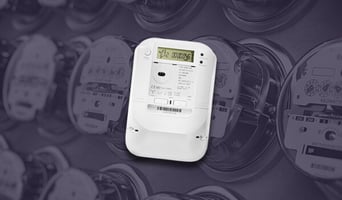


SUBSCRIBE NOW
Stay ahead of the curve—subscribe to our newsletter for the latest insights and innovations in power conversion technology!